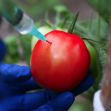One out of five children in the United States is obese. The rates for Hispanic and Black children are even higher, putting them at greater risk for dangerous health conditions. Over 30 million American children now rely on free or reduced-priced school breakfasts and/or lunches. But history shows that attempts to improve the nutritional content of these meals come and go, largely depending on who is in the White House. Now, there is a new proposal from President Biden’s Department of Agriculture (USDA) that seeks to provide healthier options in school cafeterias, vending machines and snack bars.
The proposal, Child Nutrition Programs, Revisions to Meal Patterns Consistent with the 2020 Dietary Guidelines for Americans, was announced on February 3 by USDA Secretary Tom Vilsack. It is available for review in the Federal Register at http://www.fns.usda.gov/cga/020113-snacks.pdf. A version of it was originally published in 2022, but implementation was delayed by the pandemic. The 200-plus page document asks for public comment on the following proposed changes to school nutrition programs:
- Sugar standards are added to school meal programs. Currently, schools may add sugar to their meals as long they meet weekly calorie limits. Schools would be required to limit sugars to less than 10% of the day’s calories. Breakfast cereals would be limited to six grams per dry ounce. Yogurt could only have 12 grams of added sugar per six ounces.
- Imposes a two-per-week limit on grain-based desserts such as granola bars and donuts.
- Allows fat-free and low-fat flavored milk after grade eight. Until then, only unflavored milk would be available.
- Mandates that 80% of the weekly grains offered must be whole grains, with the remainder being enriched grains. Individual products must be at least 50% whole grains, with the rest being bran or germ.
- Requires that meals, but not individual products, meet sodium standards that start at 1,100 mg. per day for grades K-5 and go up to 1,280 mg. per day for grades 9-12.
- Snacks as well as breakfast and lunch have new standards that parallel those for meals.
The rise in childhood obesity, aided by the pandemic’s exercise-limiting quarantines and added screen time, has prompted the American Academy of Pediatrics to “Promote a more aggressive approach” to treatment.” Its controversial ideas include medicating obese children as young as 12 and telling parents to consider bariatric surgery, a procedure that makes changes to the stomach or intestines that limit how much the child would be able to eat or reduce the body’s ability to absorb nutrients.
It is not only these drastic measures to control childhood obesity that has caused concern. One of its primary deterrents, government-sponsored school nutrition programs, like the one recently proposed by USDA, has long been controversial.
America’s history of feeding those in need is a long one. Charitable organizations in Philadelphia and Boston began feeding kids at school in the early 1900s after studies showed poverty made learning difficult. Education leaders realized that schools must get involved in operating and supporting school lunch programs, but schools could not do it alone. Help from the government was essential. In addition, the depression and World War II caused farmers to lose their markets. School lunch programs would be able to buy staples from farmers and sell them to schools. A win-win.
USDA got involved in 1946 when President Truman signed the National School Lunch Program Act. It contained funding formulas to subsidize schools for lunches that “met the minimum nutritional requirements” set by the USDA Secretary. But Congress soon began to struggle with how it would work and how much it would cost. At first, all states got the same amount per student. But that formula was soon replaced by one that gave more funds to states with greater need.
The program was expensive. In 1968, it cost $160 million and caused a backlash. Critics argued that feeding children was the parents’ responsibility. But President Johnson felt differently. He said that not only was funding essential, but “poor and non-poor alike, must be reminded that a proper diet is a basic determinant of good health.” A new agency, the Food and Nutrition Service (FNS), was created within USDA to administer federal food programs.
As the cost of school nutrition continued to rise, budget cuts followed along with different ideas about the definition of “minimum nutritional requirement.” In the 1980s President Ronald Reagan cut $1.46 billion from child nutrition programs, while he famously proclaimed that ketchup was a vegetable.
First Lady Michelle Obama ushered in revised federal support for healthy school lunches as part of her “Let’s Move.” She sought to decrease childhood obesity from 20% to 5% by 2030. President Obama increased the reimbursement rate from the federal government to schools for the first time in 30 years.
But in 2020, President Trump’s “Budget for a Better America,” proposed cutting $1.7 billion from school meals by 2022. He also asked schools to increase scrutiny over those who claim they are qualified to participate.
President Biden entered the budget yo-yo scenario when he added $750 million for school lunch programs in 2022. And now, for the first time, USDA is setting healthy nutritional requirements for school feeding programs. But it is likely that many “multinational food companies with economic power, lobbyists and communication and marketing resources” will continue to “actively oppose policies about healthier foods,” according to BMJ, a global healthcare knowledge provider.
The press release from USDA about the new child nutrition proposal says that the agency “expects that the product-specific limits in this proposal would incentivize the school food industry to develop products with less added sugars.”
But this optimism might be misplaced because history shows that the battle of children’s health v. sugared cereals, chocolate milk, sugary granola bars, and salty snacks is likely to persist.






